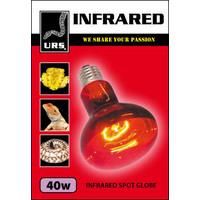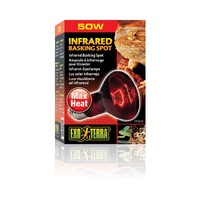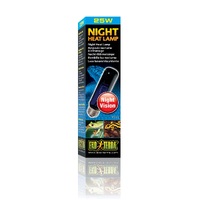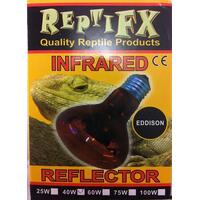Reptile Light Bulbs & Globes
Shop a range of reptile bulbs & globes including nighttime, daylight, infrared, heat and neodymium reflectors. Having the correct lighting is important to the health of your reptile. Most reptiles including snakes, lizards, turtles and amphibians require lighting to help replicate their natural habitat. Some reptile species may require both daytime and nighttime bulbs to mimic their natural environment.
About Reptile Light Bulbs
When it comes to providing lighting for a reptile, it's important to first determine the specific needs of the species you are keeping. Some reptiles, like nocturnal or crepuscular species, may not require any additional lighting beyond ambient room light, while others may benefit from certain types of lighting to help regulate their behaviour and health.
Your reptile requires additional lighting like most, the recommended type of light bulb is a low-wattage incandescent lamp, such as a nighttime, moonlight or daytime bulb. These globes emit a low level of heat and a soft, dim light, which can help mimic the natural lighting conditions of a reptile's native environment. It's important to avoid using high-wattage bulbs in small enclosures, as these can overheat the enclosure and potentially harm your reptile. It is essential to always ensure you use a thermostat with your light bulbs to ensure your enclosure does not get too hot.
Some reptile owners may choose to use fluorescent bulbs, which can provide a broader spectrum of light and may help promote natural behaviours and health. However, it's important to ensure that any fluorescent bulbs used emit UVB, as this is essential for the synthesis of vitamin D3 in reptiles.
Reptile Light Bulb FAQ's
Do all reptiles require lighting?
Most reptiles do require some sort of lighting. Some species are nocturnal or crepuscular, so will prefer low light levels. However, most species including snakes, lizards & turtles will benefit from lighting to help regulate their behaviour.
What kind of bulb is best for my reptile?
The best type of bulb for your reptile will depend on the species and its individual needs. Low-wattage incandescent bulbs, such as "nighttime" or "moonlight" bulbs are commonly used, as well as “daylight” bulbs for the majority of species. Some owners may also choose to use fluorescent bulbs that emit UVB, which are essential for the synthesis of vitamin D3 in reptiles. Heating is required for all reptiles, some people choose to provide this with a bulb, others will use a heat mat. When using a heat emitting bulb, it is important to use a thermostat in conjunction with the bulb.
How long should a light bulb be switched on for my reptile?
The length of time a light bulb should be on for a reptile will depend on the species and its individual needs. In general, most reptiles require 10–14 hours of light per day, with a period of darkness at night to simulate natural light cycles. You are replicating their natural environment, so their terrarium should emulate how they would live in the wild.
Can I use a regular household bulb for my reptile?
No, It is not recommended to use a regular household light bulb for your reptile as these bulbs can emit either too much heat, or not enough, and potentially harm your pet. It's important to choose a bulb specifically designed for reptiles, with the appropriate wattage and light output for your pet's needs.
Why are some light bulbs a different colour to others?
Depending on the light bulb you are using and what species you are using them for, some may be different in colour. Nocturnal or crepuscular reptiles benefit from having a moonlight or nighttime bulb, as this best replicates their natural environment. They are most active at nighttime, so by mimicking the natural light produced by the moon it stimulates activity, feeding and breeding for that reptile. Reptiles that diurnal benefit most from having a daylight, fluorescent, or infrared bulb depending on their species and individual needs.
How do I know which light bulb will correctly fit into my light bulb fixture?
Most bulb fittings are E27 screw ins. By checking the fitting, it will have the exact fitting requirement written on it. Most light bulbs are screw in, however they may be the occasional bayonet fitting (clip in) globe fitting.
How do I know what wattage bulb I need?
Depending on the size of your enclosure and the individual animal's needs, will decipher which wattage you should buy. Some reptiles require a higher heat as the climate in which they inhabit is warmer. Some will require a slightly lower heat as their climates are colder. It is important to research the reptile species you own, and learn where they originate from, to decide what wattage light bulb you should purchase. The size of the enclosure in which your reptile lives in also plays a part in the wattage of the bulb you should purchase. Generally, the larger the enclosure, the higher wattage you will require and vice versa. This is to ensure you are adequately heating the whole enclosure.
Where should I place my bulb within the enclosure?
It is best to place your heat emitting bulb on one side of the enclosure. This ensures there is a temperature gradient, so that your reptile can seek more heat when it feels it needs it, but also has a slightly cooler side to reside to if need be at when it feels it needs it, but also has a slightly cooler side to reside to if need be.
The information on this page about reptile bulbs & globes has been verified by reptile expert Bo Buiatti from AB Reptiles. Find out more about AB Reptiles on Facebook or Instagram.
Checkout with Afterpay, Zippay, Visa, Mastercard or American Express.

 for Dog Products & Supplies
for Dog Products & Supplies
 for Dog Food
for Dog Food
 for Cat Products & Supplies
for Cat Products & Supplies
 for Cat Food
for Cat Food
 for Reptiles
for Reptiles
 for Small Animals
for Small Animals
 for Aquarium
for Aquarium
 for Bird Products & Supplies
for Bird Products & Supplies
































